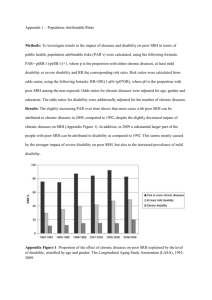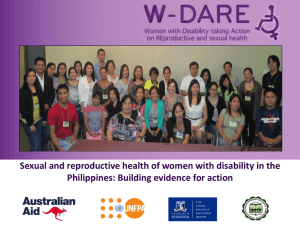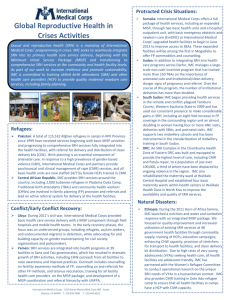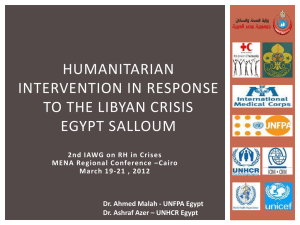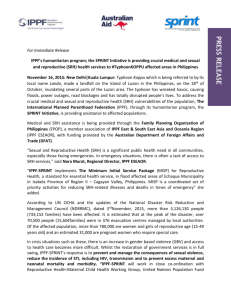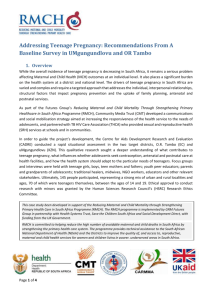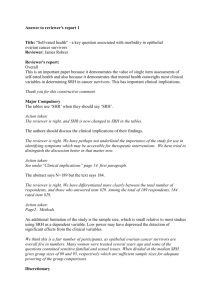First Report on Self‑Rated Health in a Nationally‑Representative
advertisement
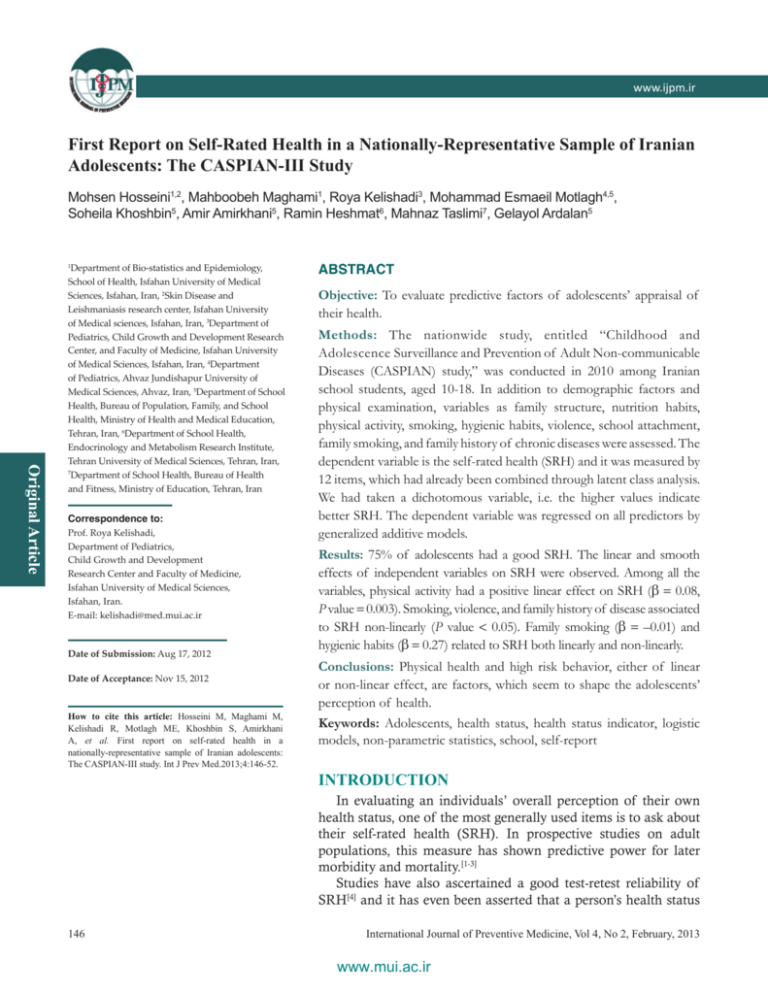
www.ijpm.ir First Report on Self‑Rated Health in a Nationally‑Representative Sample of Iranian Adolescents: The CASPIAN‑III Study Mohsen Hosseini1,2, Mahboobeh Maghami1, Roya Kelishadi3, Mohammad Esmaeil Motlagh4,5, Soheila Khoshbin5, Amir Amirkhani5, Ramin Heshmat6, Mahnaz Taslimi7, Gelayol Ardalan5 Original Article 1 Department of Bio-statistics and Epidemiology, School of Health, Isfahan University of Medical Sciences, Isfahan, Iran, 2Skin Disease and Leishmaniasis research center, Isfahan University of Medical sciences, Isfahan, Iran, 3Department of Pediatrics, Child Growth and Development Research Center, and Faculty of Medicine, Isfahan University of Medical Sciences, Isfahan, Iran, 4Department of Pediatrics, Ahvaz Jundishapur University of Medical Sciences, Ahvaz, Iran, 5Department of School Health, Bureau of Population, Family, and School Health, Ministry of Health and Medical Education, Tehran, Iran, 6Department of School Health, Endocrinology and Metabolism Research Institute, Tehran University of Medical Sciences, Tehran, Iran, 7 Department of School Health, Bureau of Health and Fitness, Ministry of Education, Tehran, Iran Correspondence to: Prof. Roya Kelishadi, Department of Pediatrics, Child Growth and Development Research Center and Faculty of Medicine, Isfahan University of Medical Sciences, Isfahan, Iran. E‑mail: kelishadi@med.mui.ac.ir Date of Submission: Aug 17, 2012 Date of Acceptance: Nov 15, 2012 How to cite this article: Hosseini M, Maghami M, Kelishadi R, Motlagh ME, Khoshbin S, Amirkhani A, et al. First report on self‑rated health in a nationally‑representative sample of Iranian adolescents: The CASPIAN‑III study. Int J Prev Med.2013;4:146-52. ABSTRACT Objective: To evaluate predictive factors of adolescents’ appraisal of their health. Methods: The nationwide study, entitled “Childhood and Adolescence Surveillance and Prevention of Adult Non‑communicable Diseases (CASPIAN) study,” was conducted in 2010 among Iranian school students, aged 10‑18. In addition to demographic factors and physical examination, variables as family structure, nutrition habits, physical activity, smoking, hygienic habits, violence, school attachment, family smoking, and family history of chronic diseases were assessed. The dependent variable is the self‑rated health (SRH) and it was measured by 12 items, which had already been combined through latent class analysis. We had taken a dichotomous variable, i.e. the higher values indicate better SRH. The dependent variable was regressed on all predictors by generalized additive models. Results: 75% of adolescents had a good SRH. The linear and smooth effects of independent variables on SRH were observed. Among all the variables, physical activity had a positive linear effect on SRH (β = 0.08, P value = 0.003). Smoking, violence, and family history of disease associated to SRH non‑linearly (P value < 0.05). Family smoking (β = –0.01) and hygienic habits (β = 0.27) related to SRH both linearly and non‑linearly. Conclusions: Physical health and high risk behavior, either of linear or non‑linear effect, are factors, which seem to shape the adolescents’ perception of health. Keywords: Adolescents, health status, health status indicator, logistic models, non‑parametric statistics, school, self‑report INTRODUCTION In evaluating an individuals’ overall perception of their own health status, one of the most generally used items is to ask about their self‑rated health (SRH). In prospective studies on adult populations, this measure has shown predictive power for later morbidity and mortality.[1‑3] Studies have also ascertained a good test-retest reliability of SRH[4] and it has even been asserted that a person’s health status 146 International Journal of Preventive Medicine, Vol 4, No 2, February, 2013 www.mui.ac.ir Hosseini, et al.: Self‑rated health in adolescents cannot be exactly evaluated without inclusion of SRH.[3] Qualitative studies have displayed that not all the respondents do use the same frame of reference in rating their subjective health. This frame of reference may also change with age.[5] Because of its great influence on adults’ life, verifying the assessment of subjective health in primary life may be of particular interest.[6] Previous studies point that many of the commonest diseases of our time can probably be viewed as consequences of long‑term processes that started from early life.[7] The adolescence period is specified by its rapid physical and psychological changes in the individuals with increasing influence of adolescent from peers, school and wider societies, including the mass media and increasing independence from parents and family.[6] Limited experience exists on the SRH status of adolescents.[8‑11] It is suggested that adolescents use different criteria for SRH status compared with adults.[11] Adults more likely use physical functioning or the presence of chronic disease to determine self rated health status,[2,3,12] whereas adolescents are may use their health‑related behaviors (including physical activity, smoking, alcohol consumption, and/or dietary intake) as frames of reference for SRH status.[8‑11,13] A cross‑sectional study was performed in 2010 on Iranian adults aged 18‑65. This study showed that most people in Iran rated their health well (71.7%). The result, using logistic regression, showed that economic status was strongly related to the health of people strongly.[14] Among the studies which were conducted in western countries, Vingilis et al. (1998) identified a series of demographic, economic, social, and psychological/behavioral factors that may be related to SRH among adolescents. They discovered that family income, gender, family attachment, school achievement, smoking, and self‑esteem were significant predictors of SRH.[15] The aim of this study was to identify some factors influencing the perceptions of SRH during the adolescence period. METHODS The methods of data collection in this study have been published previously in details[16] and we are reporting a brief summary here. This national multi‑center study entitled “childhood adolescences surveillance and prevention of adult non‑communicable diseases (CASPIAN) study” was conducted in 2010 on 5528 school students, aged 10‑18, living in urban and rural areas in 27 provinces of Iran. We only considered middle and high school students; therefore, we obtained a sub‑sample of 3843 students in the present study. The study was approved by ethics committees and other relevant national regulatory organizations. The Data and Safety Monitoring Board for the project was involved in closely supervising the quality control and quality assurance of measures for the survey at a national level. Written informed consent was obtained from parents and oral assent from students. The project team selected students by multistage, random cluster sampling. They stratified schools according to location (urban/rural), and the socioeconomic nature of their uptake areas, taking into consideration the proportion of the different types of schools (public/private) to avoid a socioeconomic bias. The questionnaires are prepared in Farsi and based the World Health Organization (WHO) stepwise approach to non‑communicable diseases (Tools version 9.5) and the WHO global school‑based student health survey.[17‑20] We selected independent variables that may be related to SRH. In most studies, SRH is measured by a single item In general, “how would you rate your health?” the response categories were “excellent,” “very good,” “good,” “fair,” and “poor.” But in this study it is measured by 12 items that consists mental and physical dimensions. So for the purposes of the present analyses we combined these 12 items by latent class analysis and then we obtained two categories: Good and poor SRH. The independent variables are age, gender, grade of student, body mass index (BMI), average of diastolic and systolic blood pressure, total cholesterol, family structure, nutrition habits, physical activity, smoking, hygienic habits, violence, school attachment, family smoking, and the family history of chronic diseases. To analyze the influence of predictors on SRH, we have use generalized additive models (GAM). In GAM, a non‑linear relation between an independent variable and a response could be modeled without determining a parametric relation between the variables. GAM are the extended International Journal of Preventive Medicine, Vol 4, No 2, February, 2013 www.mui.ac.ir 147 Hosseini, et al.: Self‑rated health in adolescents mode of generalized linear model by replacing the linear predictors by unspecified non‑parametric smoothing functions.[21] Using the “back fitting” algorithm, we calculated the curves iteratively while they were cycling through all predictors until the optimal multivariate fit is gained. The general formula of a GAM is: p ( ) g ( µ ) = α + ∑ f j x j + ε j= 1 Where g (m) is canonical function, a is the intercept and fj (xj) are smooth (cubic spline) functions of independent variables, C contains the categorical variables that in this study are gender and grade. The “smoothness” of the functions is an important issue. If the smoothness of a function is too much, curvature of interest may not be found, and therefore, the relation could be biased. Correspondingly, if the function is smoothed too little, the relation will be rough and have a high variance. The degree of freedom controlled the smoothness. The degree of smoothing can be determined through looking at the estimated graph for a range of choices of smoothing and Akaikes information criterion. Furthermore, it can be estimated using cross‑validation automatically. χ2 tests are used to work out the significance of the linear and non‑linear terms, and χ2 approximation for the deviance is useful for comparing models, and could be used in model selection. GAMs’ result shows the curves, which visualize the influence of the independent variable on the outcome, over the range of the independent variable when the effects of the other independent variables have been taking into account. In this study, SRH is a dichotomous variable. So we use generalized logistic additive models.[21,22] Descriptive analysis has conducted using SPSS 16.0 (SPSS Inc., Chicago, Illinois, USA). Logistic additive models and latent class analysis have been conducted using proc GAM and proc Latent class analysis (LCA) in SAS version 9.2 respectively. RESULTS Descriptive finding The sample comprised 3827 participants among the middle and high school students. The descriptive statistics of SRH and independent variables are shown in Table 1. In this population, 148 49.7% are boys and 50% are high school students. Some variables such as family structure, nutrition habits, physical activity, smoking, hygienic habits, school attachment, violence, and family history of chronic disease are included some items. To achieve these variables, we summed the items. Therefore, the possible maximum score for each variable is shown in Table 1. We could compare the maximum scores and means for each of these variables and realize the situation of students regarding each variable. We see that 75% of adolescents rated their health good, of which 49% are boys. Approximately boys and girls rated their health similarly. We compared the means of quantitative variables across two levels of SRH by t‑test. Pearson correlation was evaluated to show the relation between SRH and qualitative variables. The results are shown in Table 2. It is evident that the levels of gender and Table 1: Descriptive statistics Variable Self‑rated health (%) Poor Good Gender (%) Male Female Grade (%) Middle school High school Age Total cholesterol Average pressure BMI Family smoking Smoking Violence Nutrition habits Hygienic habits School attachment Physical activity Family structure Family disease N Mean/ Standard Possible proportion deviation maximum score 3827 957 2870 3825 1902 1923 3827 1915 1912 3827 3827 3827 25 75 50 50 16.19 146.23 86.27 1.82 28.91 10.40 3827 3743 3798 3446 2717 3687 3670 20.40 4.11 1.54 17.75 40.96 15.12 26.64 4.07 2.39 1.67 7.86 5.64 2.29 4.42 12 12 54 58 19 44 3710 33428 2894 8.17 17.35 12.11 2.60 3.93 4.02 14 32 40 49.7 50.2 BMI=Body mass index International Journal of Preventive Medicine, Vol 4, No 2, February, 2013 www.mui.ac.ir Hosseini, et al.: Self‑rated health in adolescents education were not associated to the levels of SRH. By t‑test we saw that the means of age, BMI, family structure, school achievement, smoking and nutrition were equal for two levels of SRH. The means of other quantitative variables were different for adolescents with good and poor SRH. Logistic additive model The dependent variable with 12 items has divided into two classes by latent class models. The self‑reported health measure was scored such that higher values indicated better health. At first, all the independent variables entered the model as non‑linear predictors. The categorical variables (gender and grade) have analyzed parametrically. For some variables, the small degree of freedom (DF) values indicated that the non‑parametric predictors were almost linear and the Chi‑square test statistics was very close to zero and the P values were not computed. These variables were age, BMI, average of blood pressure, total cholesterol, family structure, nutrition habits, physical activity, and school achievement. These numerical results and the visualization in the smoothing component plot suggested that no obvious nonlinearities remained for these variables in the logistic additive model. So these variables have entered the model linearly. The smoking, family history of disease, hygienic habits, family smoking, and violence remain non‑linear predictors in the models. In the next step the variables without linear effect on SRH removed from the model. Regression model analysis was computed automatically in proc GAM. Table 3 provides analytical information about parametric estimates for the linear portion of the model. The sign of coefficient shows the direction of effects. A positive coefficient suggests the increase of the independent variable is associated with the higher SRH scores. Namely the physical activity and hygienic habits have positive effect on good SRH. Family smoking is positively associated with poor SRH. Smoking, violence, and family history of disease did not have a linear effect on SRH but have a smoothing effect on it [Table 4]. This means that just using linear models such logistic linear model we could not find the effect of these variables. Table 4 includes fit summary for smoothing components and the analysis of deviance. It Table 2: T test statistic and pearson Chi‑square for independent variables in two levels of self‑rated health Self‑rated health Independent variables Gender Level of education Total cholesterol Age BMI Family structure Family disease School achievement Hygienic habits Physical activity Family smoking Smoking Nutrition Violence Average blood pressure t test Pearson χ2 P value ‑ ‑ −2.371 0.76 0.99 −1.49 2.28 0.664 −23.16 −12.21 25.53 1.85 −1.218 4.29 4.39 2.148 0.192 ‑ ‑ ‑ ‑ ‑ ‑ ‑ ‑ ‑ ‑ ‑ ‑ ‑ 0.143 0.661 0.018 0.448 0.322 0.137 0.023 0.507 0.000 0.000 0.000 0.064 0.223 0.000 0.000 N 3825 3827 3827 3827 3827 3428 2894 3670 3687 3710 3743 3798 2717 3446 3827 BMI=Body mass index Table 3: Regression model analysis, parameter estimates Parameter Standard t value Pr>|t| estimate error Intercept −1.42 0.64 −2.23 0.026 Physical activity 0.08 0.03 3.01 0.003 Linear −0.01 0.01 −1.02 <0.0001 (family smoking) Linear (violence) −0.35 0.03 −12.98 0.985 Linear (smoking) 0.00 0.01 0.02 0.939 Linear −0.02 0.04 0.08 0.080 (family disease) Linear 0.27 0.01 −1.75 <0.0001 (hygienic habits) Parameter Table 4: Smoothing model analysis, analysis of deviance Source DF Sum of squares Spline (family smoking) 8.51 182.05 Spline (violence) 3.30 22.98 Spline (smoking) 5.70 25.51 Spline (family disease) 1.20 4.43 Spline (hygienic habits) 5.28 48.34 Chi‑ Pr>Chi sq square 182.05 <0.0001 22.98 <0.0001 25.51 0.0002 4.43 0.0467 48.34 <0.0001 DF=Degree of freedom indicates that five smoothing terms of smoking, violence, hygienic habits, family disease, and family smoking are statistically significant. You can clearly see these non‑linearities in the smoothing component plots [Figure 1]. International Journal of Preventive Medicine, Vol 4, No 2, February, 2013 www.mui.ac.ir 149 Hosseini, et al.: Self‑rated health in adolescents Figure 1: Smooth effect of independent variables DISCUSSION In all the studies on evaluation of the SRH, a single question was used “How would you rate your health in general?”[6,10,15,23‑28] However, in this study, we have combine 12 items (including this question, as well) by using the latent class models and have obtained a single dichotomous item. This method is more general because includes physical and emotional sense of adolescents health. Among all independent variables entered the model, only physical activity, smoking, family smoking, hygienic habits, family history of disease and violence were statistically associated to SRH. In cross‑sectional studies, associations between physical activity and SRH in children and adolescents have been evaluated, which show that powerful activity is associated with good SRH. In this study, physical activity had a positive effect on good SRH. It means that students who more active, more likely report their health good. Similar findings have been reported in a Swedish cohort study on 15 years old students and in a cross‑sectional study on 11‑12‑year old boys and girls from the United Kingdom, which showed that SRH was significantly related to whether or not the adolescents were currently exercising in both genders.[25] 150 Countless studies have shown statistically significant relationship between smoking status and poor SRH. In these studies, a higher level of health was reported among adolescent who were at a lower level of tobacco use.[10,15,24,26,29] In our study, t‑test analysis and parametric analysis showed that the smoking was not associated with SRH linearly, but it had a non‑linear impact on SRH. We can see this non‑linearity in the plot [Figure 1]. In general, its diagram has a descending pattern. Exposure to violence associated to SRH as smooth effect only. The smooth effect has been shown in Figure 1. This variable in childhood and adolescence constitutes a pervasive public health problem.[30,31] The study on the US adolescent indicated that as individuals were exposed to increasing amounts of violence, their SRH would decline.[27] Another article examined the effects of harassment and victimization on self‑rated and mental health status among Canadian adolescents aged 16‑17. This study concluded that harassment at school was found to be a robust predictor of children’s self‑reported and mental health status.[26] However, our study was in agreement with this study in showing the descending effect of violence on SRH. The family smoking had linear and non‑linear relationships with to SRH. The sign of its coefficient International Journal of Preventive Medicine, Vol 4, No 2, February, 2013 www.mui.ac.ir Hosseini, et al.: Self‑rated health in adolescents is negative. So it is negatively associated to a high SRH. This result confirmed the study which was about the role of parents on adolescents’ SRH.[28] We could not find the impact of family history of disease and hygienic habits on adolescents’ SRH in previous studies. These two variables have been considered in our study. The family history of diseases did not associate to SRH linearly. However, its descending non‑linear effect is shown in Figure 1. Similarly, hygienic habits in adolescents associated to SRH non‑linearly. Its non‑linear effect on SRH is ascending in its diagram. Our study showed that boys and girls rated their health similarly and the gender variable did not associate to SRH. Previous study had different results about relation between SRH and gender. In the studies that gender had significant association to SRH; girls rated their health poorer.[10,15,24,25,27] Age and the grade of student did not have any impact on SRH. Our study is consistent with the study of Vinglis et al. and study of Wade et al.[15,24] while inconsistent with the study of Vinglis and et al. (2002), which indicated that age is a predictor of SRH.[10] In previous studies of adolescents, the effect of hypertension and cholesterol on adolescents SRH were not evaluated. However, a study on the middle‑aged and elderly Chinese which examined the relationship between SRH and cardio‑metabolic disease indicated that participants who had cardiovascular diseases, diabetes, hypertension and metabolic syndrome were more likely to have a poor SRH.[32] In our study the average of blood pressure and total cholesterol did not have statistically a significant effect on SRH. Furthermore, BMI in adolescents did not associate to SRH. However, Evelyn et al. showed that adolescent with top quintile of BMI had lower health rating.[10] About nutrition habit, a longitudinal study on adults Danish indicated that poor dietary intake related to poor SRH. A US adolescents’ study showed that SRH status is not related to the overall quality of the adolescents’ diet. In our study, nutrition habits did not associate to SRH, so confirmed the US study.[23] Other variables that did not associate to SRH are family structure and school achievement. In other studies, it was found that students who had better family structure and family finance situation had better SRH[10,15] and school achievement had a positive effect on high SRH.[10] Limitations Among the factors that seem to be related to adolescents’ SRH were mental dimensions such as stress, depression, and other mental problems. However, these factors were not measured in the case of adolescent concerning the national study, therefore, these factors were not considered in this study. CONCLUSION In our studies, we could find the effective variables on SRH which other studies had not examined them directly. These variables are hygienic habits and family history of chronic disease. Furthermore, by using GAM, we realized the smooth effect of some variables, which had linear impact on SRH in previous studies. In general, we could find both the smooth and linear effects of independent variables. We concluded that the factors which influenced adolescents’ SRH were relevant to physical activity and high‑risk behavior in adolescents and their family, so adolescents with further physical activity and less high‑risk behaviors had better concept of their health. REFERENCES 1. Manderbacka K, Lahelma E, Martikainen P. Examining the continuity of self‑rated health. Int J Epidemiol 1998;27:208‑13. 2. Fylkesnes K. The Troms study: Predictors of self‑evaluated health: Has society adopted the expanded health concept?. Soc Sci Med 1991;32:141‑6. 3. Idler EL, Benyamini Y. Self‑rated health and mortality: A review of twenty‑seven community studies. J Health Soc Behav 1997;38:21‑37. 4. Lundberg O, Manderbacka K. Assessing reliability of a measure of self‑rated health. Scand J Soc Med 1996;24:218‑24. 5. Krause NM, Jay GM. What do global self‑rated health items measure? Med Care 1994;32:930‑42. 6. Breidablik HJ, Meland E, Lydersen S. Self‑rated health during adolescence: Stability and predictors of change (Young‑HUNT study, Norway). Eur J Public Health 2009;19:73‑8. 7. Eder A. Risk factor loneliness. On the interrelations between social integration, happiness and health in 11‑, 13‑and 15‑year old schoolchildren in 9 European countries. Health Promot Int 1990;5:19‑33. International Journal of Preventive Medicine, Vol 4, No 2, February, 2013 www.mui.ac.ir 151 Hosseini, et al.: Self‑rated health in adolescents 8. Mechanic D, Hansell S. Adolescent competence, psychological well‑being, and self‑assessed physical health. J Health Soc Behav 1987;28:364‑74. 9. Lowry R, Kann L, Collins JL, Kolbe LJ. The effect of socioeconomic status on chronic disease risk behaviors among US adolescents. JAMA 1996;276:792‑7. 10. Vingilis ER, Wade TJ, Seeley JS. Predictors of adolescent self‑rated health. Analysis of the National Population Health Survey. Can J Public Health 2002;93:193‑7. 11. Wade TJ, Vingilis E. The development of self‑rated health during adolescence: An exploration of inter‑ and intra‑cohort effects. Can J Public Health 1999;90:90‑4. 12. Appels A, Bosma H, Grabauskas V, Gostautas A, Sturmans F. Self‑rated health and mortality in a Lithuanian and a Dutch population. Soc Sci Med 1996;42:681‑9. 13. Dowdell EB, Santucci ME. Health risk behavior assessment: Nutrition, weight, and tobacco use in one urban seventh‑grade class. Public Health Nurs 2004;21:128‑36. 14. Vahdaninia M, Abadi M, Azin SA, Aienprast A, Omidvari S, Jahangiri K, et al. How the people rate their health: Studying of health on Irianian people. Payesh Health Monit 2011;10:355-63. 15. Vingilis E, Wade TJ, Adlaf E. What factors predict student self‑rated physical health? J Adolesc 1998;21:83‑97. 16. Kelishadi R, Heshmat R, Motlagh ME, Majdzadeh R, Keramatian K, Qorbani M, et al. Methodology and early findings of the third survey of CASPIAN study: A national school‑based surveillance of students’ high risk behaviors. Int J Prev Med 2012;3:394‑401. 17. Kelishadi R, Ardalan G, Gheiratmand R, Gouya MM, Razaghi EM, Delavari A, et al. Association of physical activity and dietary behaviours in relation to the body mass index in a national sample of Iranian children and adolescents: CASPIAN Study. Bull World Health Organ 2007;85:19‑26. 18. Kelishadi R, Ardalan G, Gheiratmand R, Majdzadeh R, Hosseini M, Gouya MM, et al. Thinness, overweight and obesity in a national sample of Iranian children and adolescents: CASPIAN study. Child Care Health Dev 2008;34:44‑54. 19. Kelishadi R, Ardalan G, Gheiratmand R, Ramezani A. Is family history of premature cardiovascular diseases appropriate for detection of dyslipidemic children in population‑based preventive medicine programs? CASPIAN study. Pediatr Cardiol 2006;27:729‑36. 20. Kelishadi R, Gheiratmand R, Ardalan G, Adeli K, Mehdi Gouya M, Mohammad Razaghi E, et al. Association of anthropometric indices with cardiovascular disease 152 risk factors among children and adolescents: CASPIAN study. Int J Cardiol 2007;117:340‑8. 21. Hastie TJ, Tibshirani RJ. Generalized additive models. Generalized Additive Models. London: Chapman & Hall/ CRC; 1990. p. 136-66. 22. Johansen D, Grønbaek M, Overvad K, Schnohr P, Andersen PK. Generalized additive models applied to analysis of the relation between amount and type of alcohol and all‑cause mortality. Eur J Epidemiol 2005;20:29‑36. 23. Goodwin DK, Knol LL, Eddy JM, Fitzhugh EC, Kendrick OW, Donahue RE. The relationship between self‑rated health status and the overall quality of dietary intake of US adolescents. J Am Diet Assoc 2006;106:1450‑3. 24. Wade TJ, Pevalin DJ, Vingilis E. Revisiting student self‑rated physical health. J Adolesc 2000;23:785‑91. 25. Elinder LS, Sundblom E, Rosendahl KI. Low physical activity is a predictor of thinness and low self‑rated health: Gender differences in a Swedish cohort. J Adolesc Health 2011;48:481‑6. 26. Abada T, Hou F, Ram B. The effects of harassment and victimization on self‑rated health and mental health among Canadian adolescents. Soc Sci Med 2008;67:557‑67. 27. Boynton‑Jarrett R, Ryan LM, Berkman LF, Wright RJ. Cumulative violence exposure and self‑rated health: Longitudinal study of adolescents in the United States. Pediatrics 2008;122:961‑70. 28. Breidablik HJ, Meland E, Holmen TL. Role of parents in adolescent self‑rated health: Norwegian nord‑trøndelag health study. Adolescent Health, Medicine and Therapeutics 2010:1 97–1042. 29. Mahmoud N. Self‑rated health status and smoking. [Thesis]: San Diego State University; 2011. p.1- 43. 30. Buka SL, Stichick TL, Birdthistle I, Earls FJ. Youth exposure to violence: Prevalence, risks, and consequences. Am J Orthopsychiatry 2001;71:298‑310. 31. Margolin G, Gordis EB. The effects of family and community violence on children. Annu Rev Psychol 2000;51:445‑79. 32. Haseli‑Mashhadi N, Pan A, Ye X, Wang J, Qi Q, Liu Y, et al. Self‑Rated Health in middle‑aged and elderly Chinese: Distribution, determinants and associations with cardio‑metabolic risk factors. BMC Public Health 2009;9:368. Source of Support: This study was conducted as a thesis funded by Isfahan University of Medical Sciences, Isfahan Iran; data of a national study (CASPIAN-III) were used in this regard., Conflict of Interest: None declared. International Journal of Preventive Medicine, Vol 4, No 2, February, 2013 www.mui.ac.ir
